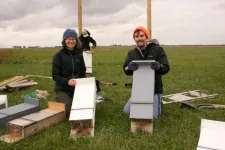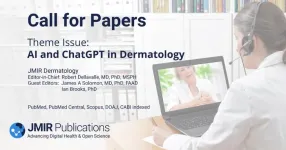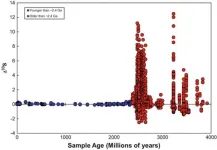(Press-News.org) URBANA, Ill. — Artificial roosts for bats come in many forms — bat boxes, condos, bark mimics, clay roosts, and cinder block structures, to name a few — but a new conservation practice and policy article from researchers at the University of Illinois Urbana-Champaign suggests the structures haven’t been studied rigorously enough and may harm bats in some scenarios. The article, published in Conservation Biology, lays out potential dangers and encourages more research on the popular conservation practice.
“The major emphasis among conservation managers using artificial roosts is how to attract bats, typically by modifying design or landscape placement,” said Reed Crawford, doctoral student in the Program in Ecology, Evolution, and Conservation Biology at Illinois and lead author on the article. “Their measure of success is roost occupancy or bat abundance in roosts, but we really have no idea whether artificial roosts positively or negatively affect bats compared with natural roosts. What we do know is there are multiple significant perils associated with these artificial structures that need additional research.”
The dangers associated with artificial roosts mean they could act as ecological traps in some cases, according to Crawford and co-author Joy O’Keefe, assistant professor and wildlife Extension specialist in the Department of Natural Resources and Environmental Sciences and Illinois Extension, both part of the College of Agricultural, Consumer and Environmental Sciences (ACES) at Illinois.
“An ecological trap occurs when animal populations preferentially select sub-optimal habitat when higher-quality alternatives are available,” Crawford explained. “Basically, bats could inadvertently lower their chances of survival and reduce their reproductive success by choosing poorly designed or placed bat boxes.”
The best-documented concern is overheating. People installing artificial roosts often follow scientifically unsubstantiated advice to choose dark-colored structures and place them in sunny locations. The small structures rarely offer any insulation and can quickly reach temperatures beyond what bats can withstand. Unfortunately, there are all too many reports of mass bat deaths, with tiny bodies piled beneath roosts on the hottest days.
Crawford, O’Keefe, and others have documented thermal gradients inside bat boxes of various shapes, sizes, colors, and materials. Most designs reach dangerous temperatures, at least for short periods. But artificial roosts can also be too cold for healthy pup development. The authors share multiple reports of freezing deaths in bats during cold snaps in Florida and elsewhere. To improve outcomes for bats, the authors suggest assessing the conditions inside new designs before offering them to bats, aiming to strike a balance between reducing overheating risk and offering bats a microclimate suitable for raising their young.
Another concern is that artificial roosts could provide easier access by predators, such as snakes or raccoons, with little room for bats to retreat or escape.
When bats roost in trees, they tend to use multiple openings, be higher off the ground, and split up into smaller groups, which might disperse guano and make it harder for predators to see them or to sniff them out. According to O’Keefe, “We need to look at predation rates in natural and artificial roosts and develop effective guards and designs that keep roosting bats safe from predators.”
In their article, the researchers highlight ectoparasite accumulation as another understudied threat associated with artificial roosts.
“We found more than a thousand bat bugs inside some of the bat boxes we had installed for a previous study. We don't know if that’s normal or if it’s just something that's happening in these artificial roosts,” Crawford said. “It could be a really big deal when you potentially have 10 bat bugs for every one bat. To a bat, those would be like a golfball-sized parasite. They could lose a lot of blood. And we know the bugs preferentially target young bats and pups that can't groom themselves as effectively.”
The researchers note bat boxes may lure bats into low-quality habitat. Urban homeowners or farmers wanting bats for mosquito or crop pest control may inadvertently reduce bats’ diet choices to just a few insect species while likely increasing their exposure to environmental pollutants and novel predators, like prowling cats. Or a well-intended land owner might put up a bat box across a busy road from a forest, increasing the odds of vehicle collisions as bats head for the trees each night.
“There’s a lot more we need to know about bat health in urban and human-altered landscapes to inform decisions about where to place artificial roosts,” Crawford said.
Despite their potential pitfalls, many artificial roosts are “successful” in attracting large colonies of bats, sometimes hundreds of individuals. But Crawford and O’Keefe say those numbers could exacerbate the dangers of artificial roosts.
“Again, that's deemed a measure of success: if you see 500 bats in one box, that's fantastic. But there's a rare tree that could support that many individuals. In my experience tracking tree-dwelling bats, a colony is often spread across multiple tree roosts in a forest,” O’Keefe said. “And so, in bat boxes, you have this concentration of bats that's potentially more vulnerable — because there's so many of them — to predators, weather extremes, and ectoparasites. Having so many bats together could compound the risks to the population.”
Given that forest habitat is shrinking and bats most definitely need help, what’s a conservation manager or a homeowner to do?
“First, we need much more research on the effects of all of these factors on bats in artificial roosts. But I’d also encourage folks to look more holistically at their landscape and provide additional resources for bats,” Crawford said. “For example, adding clean water sources or maybe putting in pollinator gardens to attract different types of insects for greater dietary diversity. Looking at the artificial roost itself, make sure it’s high enough off the ground and not so small as to heighten exposure to overheating or predators.”
O’Keefe added, “I encourage people to look beyond their own backyards and think about whether there's a better place to install a roost nearby, like a park, that also offers foraging habitat for bats. Think at the neighborhood or village scale, as bats cover a lot of ground across their roosting and foraging areas. And no one should be putting up artificial roosts and walking away. You should be paying attention to them, keeping an eye on the bats and what's going on in and around the structure, including predators and ectoparasites, to know how bats using that structure might be affected.”
O’Keefe’s laboratory maintains a website with tips for making bat boxes safer for bats.
The article, “Improving the science and practice of using artificial roosts for bats,” is published in Conservation Biology [DOI: 10.1111/cobi.14170].
END
Do artificial roosts help bats? Illinois experts say more research needed
2023-08-31
ELSE PRESS RELEASES FROM THIS DATE:
JMIR Dermatology call for papers theme issue on AI and ChatGPT in dermatology
2023-08-31
JMIR Dermatology Editor-in-Chief: Robert Dellavalle, MD, PhD, MSPH and guest editors James A Solomon, MD, PhD, FAAD and Ian Brooks, PhD welcome submissions to a special theme issue examining "Artificial Intelligence (AI) and ChatGPT in Dermatology."
JMIR Dermatology welcomes all topics related to diseases of the skin, hair, and nails, with a wide breadth and depth of papers focusing on AI applications. All topics at the intersection of dermatology, AI, and ChatGPT are eligible for this theme issue.
The journal ...
An ‘introspective’ AI finds diversity improves performance
2023-08-31
An artificial intelligence with the ability to look inward and fine tune its own neural network performs better when it chooses diversity over lack of diversity, a new study finds. The resulting diverse neural networks were particularly effective at solving complex tasks.
“We created a test system with a non-human intelligence, an artificial intelligence (AI), to see if the AI would choose diversity over the lack of diversity and if its choice would improve the performance of the AI,” says William Ditto, professor of physics at North Carolina State University, director ...
Penn State professor to lead field campaign to study climate in Baltimore area
2023-08-31
UNIVERSITY PARK, Pa. — Kenneth Davis, professor of atmospheric and climate science at Penn State, will lead a team of 23 investigators from 13 research institutions in a new field campaign supported by the U.S. Department of Energy (DOE) to study surface-atmosphere interactions around Baltimore, Maryland, to see how they influence the city’s climate. The new campaign, called the Coast-Urban-Rural Atmospheric Gradient Experiment (CoURAGE), is expected to start in October 2024 and run through September 2025.
CoURAGE will contribute to the Baltimore Social-Environmental ...
Covid pandemic may have changed the gut bacteria of infants, research finds
2023-08-31
Infants who spent most of their first year in the pandemic have fewer types of bacteria in their gut than infants born earlier, according to a team of developmental psychology researchers.
The findings, published in Scientific Reports, showed that infants whose gut microbes were sampled during the pandemic had lower alpha diversity of the gut microbiome, meaning that there were fewer species of bacteria in the gut. The infants had a lower abundance of Pasteurellaceae and Haemophilus—bacteria that live within humans and can cause various infections—and significantly different beta diversity, which tells us how similar or dissimilar the gut microbiome for ...
New blood test gives very high accuracy to screen for Alzheimer’s disease
2023-08-31
A new blood test called p-tau217 shows promise as an Alzheimer's disease biomarker, and when used in a two-step workflow very high accuracy to either identify or exclude brain amyloidosis, the most important and earliest pathology. That is an innovation now presented by researchers at the University of Gothenburg, together with colleagues at University of Lund and in Montreal, Canada.
In recent years, a lot of effort has been put on developing biomarkers in blood that could potentially help to identify Alzheimer’s disease (AD). Tau protein, ...
Antioxidants stimulate blood flow in tumors
2023-08-31
Vitamin C and other antioxidants stimulate the formation of new blood vessels in lung cancer tumours, a new study from Karolinska Institutet published in The Journal of Clinical Investigation shows. The discovery corroborates the idea that dietary supplements containing antioxidants can accelerate tumour growth and metastasis.
“We’ve found that antioxidants activate a mechanism that causes cancer tumours to form new blood vessels, which is surprising, since it was previously thought that antioxidants have a protective effect,” says study leader Martin Bergö, professor at the ...
Talk therapy with other moms an effective treatment for postpartum depression, McMaster research shows
2023-08-31
HAMILTON, ON (Aug. 31, 2023) – An innovative model of care that offers new mothers psychotherapy delivered by other mothers who have also experienced post-partum depression (PPD) should be implemented in clinical practice, according to researchers at McMaster University.
Researchers worked with nearly 200 mothers over a year and a half, during the height of the COVID-19 pandemic, and found those receiving treatment from their peers were 11 times more likely to experience remission of their major depressive disorder. The findings of the randomized control trial are published in Acta Psychiatrica Scandinavica.
PPD and its associated symptoms affect ...
Single-dose psilocybin treatment for major depressive disorder
2023-08-31
About The Study: In a randomized clinical trial with 104 participants, psilocybin treatment was associated with a clinically significant sustained reduction in depressive symptoms and functional disability, without serious adverse events. These findings add to increasing evidence that psilocybin—when administered with psychological support—may hold promise as a novel intervention for major depressive disorder.
Authors: Charles L. Raison, M.D., of Usona Institute in Fitchburg, Wisconsin, is the corresponding author.
To access the embargoed study: Visit our For The Media website at ...
Deaths due to COVID-19 in patients with cancer during different waves of the pandemic in the US
2023-08-31
About The Study: The findings of this study suggest that patients with cancer had a disparate burden of COVID-19 mortality during the winter Omicron wave compared with the general U.S. population. With the emergence of new, immune-evasive SARS-CoV-2 variants, many of which are anticipated to be resistant to monoclonal antibody treatments, strategies to prevent COVID-19 transmission should remain a high priority.
Authors: Chi-Fu Jeffrey Yang, M.D., of Massachusetts General Hospital in Boston, is the corresponding ...
New research reveals Earth's ancient ‘breath’: Study reveals connection between atmospheric changes and mantle chemistry
2023-08-31
An international team of scientists have uncovered an important link between Earth’s early atmosphere and the chemistry of its deep mantle.
The study, which was led by researchers at the University of Portsmouth and University of Montpellier, sheds new light on the evolution of life on our planet and the rise of atmospheric oxygen.
The team investigated magmas formed in ancient subduction zones, where portions of Earth’s crust sink back into the mantle, from a pivotal moment in Earth's history – the Great Oxidation Event (GOE). This event, which is estimated to have happened between 2.1 ...




